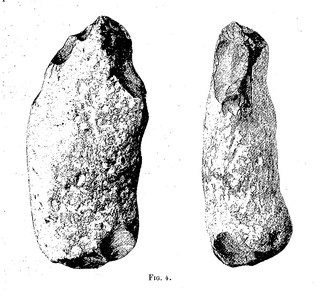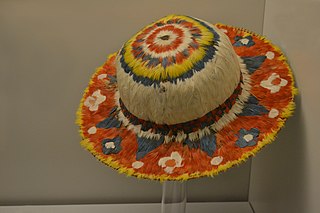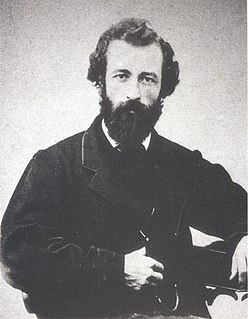Sources and external links
- H. James Birx [ed.] Encyclopedia of Anthropology (2006, SAGE Publications; ISBN 0-7619-3029-9)
- Reader's Guide — list of entries (PDF)
The Encyclopedia of Anthropology is an encyclopedia of anthropology edited by H. James Birx of Canisius College and SUNY Geneseo.
The encyclopedia, published in 2006 by SAGE Publications, is in five volumes, and contains over 1,200 articles by more than 300 contributors. Entries include the main people, concepts, and theories, in anthropology, but also relevant topics from other disciplines, such as politics, psychology, linguistics, philosophy, and archaeology.

Chiromyiformes is an order of strepsirrhine primates that includes the aye-aye from Madagascar and its extinct relatives.

Brachiation, or arm swinging, is a form of arboreal locomotion in which primates swing from tree limb to tree limb using only their arms. During brachiation, the body is alternately supported under each forelimb. This form of locomotion is the primary means of locomotion for the small gibbons and siamangs of southeast Asia. Gibbons in particular use brachiation for as much as 80% of their locomotor activities. Some New World monkeys, such as spider monkeys and muriquis, were initially classified as semibrachiators and move through the trees with a combination of leaping and brachiation. Some New World species also practice suspensory behaviors by using their prehensile tail, which acts as a fifth grasping hand. Evidence has shown that the extinct ape Proconsul from the Milocene of East Africa developed an early form of suspensory behaviour, and was therefore referred to as a probrachiator.

Raoul Weston La Barre (1911-1996) was an American anthropologist, best known for his work in ethnobotany, particularly with regard to Native-American religion, and for his application of psychiatric and psychoanalytic theories to ethnography.
Urban studies is based on the study of the urban development of cities. This includes studying the history of city development from an architectural point of view, to the impact of urban design on community development efforts. The core theoretical and methodological concerns of the urban studies field come from the social science disciplines of history, economics, sociology, geography, political science, anthropology, and the professional fields of urban planning, architecture, landscape architecture, and urban design. Urban studies helps with the understanding of human values, development, and the interactions they have with their physical environment.
Robert John Braidwood was an American archaeologist and anthropologist, one of the founders of scientific archaeology, and a leader in the field of Near Eastern Prehistory.

An eolith is a knapped flint nodule. Eoliths were once thought to have been artifacts, the earliest stone tools, but are now believed to be geofacts.

Fa Hien Cave, also Pahiyangala Cave, is situated in the district of Kalutara, Western Province, Sri Lanka and according to a rural legend, named after an alleged resident during historical times, namely Buddhist monk Faxian. However, there is no archaeological or historical evidence to support this legend. Nonetheless, the site is of archaeological significance as Late Pleistocene human fossilized skeletal remains were discovered in the cave's sediments during excavations in the 1960s, the 1980s and in 2013.

Harry James Birx, is an American anthropologist and a professor of Anthropology at Canisius College in Buffalo, New York. He is a distinguished research scholar at the State University of New York at Geneseo.

The Cholones are a tribe of South American Indians in Peru, living on the left bank of the Huallaga River in the Amazon valley. The name is that given them by the Spanish. They were first met by the Franciscans, who established mission villages among them in 1676.
Pamela Rae Huteson is an Alaska Native author and illustrator, from Prince of Wales Island in Southeast Alaska. She is both Tlingit and Haida, of the Shungkweidi Eagle moiety, from the Wolf House.

Victor John Stenger was an American particle physicist, philosopher, author, and religious skeptic.

The Geoscience Research Institute (GRI) is a creationist institute of the Seventh-day Adventist Church founded in 1958 and located on the campus of Loma Linda University in California.
An ango (安居), or kessei (結制), is a Japanese term for a three-month period of intense training for students of Zen Buddhism, lasting anywhere from 90 to 100 days. The practice during ango consists of meditation (zazen), study, and work.
Batadombalena is an archaeological site with evidence of habitation from 8,000 years BCE, Balangoda Man, located 85 km (52.8 mi) from Colombo in Sri Lanka, a two-hour drive from Colombo.
Wavula Pane is a cave located in Bulutota Rakwana range, northwest of Embilipitiya one of the archeological site located in Sri Lanka. The cave is located in the Ratnapura District, in the Kolonne Korale, about 278 metres (912 ft) above sea level. The meaning of Wavul Pane is Cave of Bats. Approximately more than 250,000 bats inhabit it.
Belilena is a well known large cave in Sri Lanka, located 8 km (5.0 mi) from the town of Kitulgala. Evidence of prehistoric human presence as early as 32,000 years ago was recorded at the site. The skeletal remains of ten individuals were discovered by Paul E. P. Deraniyagala, who attributed them to Balangoda Man. Balangoda Man is assumed to have lived as early as 32,000 years ago and occupied high altitude territories of up to 2,000 ft (609.6 m) above sea level.

Giovanni Canestrini was an Italian naturalist and biologist and translator who was a native of Revò.

Tomorrow is a temporal construct of the relative future; literally of the day after the current day, or figuratively of future periods or times. Tomorrow is usually considered just beyond the present and counter to yesterday. It is important in time perception because it is the first direction the arrow of time takes humans on Earth.
Roland Bird was an American palaeontologist. He is best known for his discovery of fossil trackways of the Paluxy River in Texas, and work with the American Museum of Natural History.
Colobus flandrini is an extinct species of colobus monkey that lived in Africa (Algeria) during the Miocene around 10 million years ago.